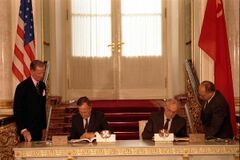Strategic Arms Reduction Treaty
(Treaty) | |
|---|---|
 | |
The Strategic Arms Reduction Treaty (START I) was a bilateral treaty between the United States and the Soviet Union on the reduction and the limitation of strategic offensive arms. The treaty was signed on 31 July 1991 by Presidents George H. W. Bush and Mikhail Gorbachev and entered into force on 5 December 1994.[1] The treaty barred its signatories from deploying more than 6,000 nuclear warheads and a total of 1,600 intercontinental ballistic missiles (ICBMs) and bombers.
START negotiated the largest and most complex arms control treaty in history, and its final implementation in late 2001 resulted in the removal of about 80% of all strategic nuclear weapons then in existence. Proposed by US President Ronald Reagan,[2] it was renamed START I after negotiations began on START II.
Contents
START II
START II was a bilateral treaty between the United States and Russia on the Reduction and Limitation of Strategic Offensive Arms. It was signed by US President George H. W. Bush and Russian President Boris Yeltsin on 3 January 1993, banning the use of multiple independently targetable reentry vehicles (MIRVs) on intercontinental ballistic missiles (ICBMs).[3] Hence, it is often cited as the "De-MIRV-ing Agreement".
It was ratified by the US Senate on 26 January 1996 with a vote of 87–4. Russia ratified START II on 14 April 2000, making it conditional on preserving the ABM Treaty. When the US withdrew from the ABM Treaty on 13 June 2002, Russia withdrew from START II one day later. Thus, START II never entered into effect.
SORT
Instead, SORT came into effect, which reduced the strategic warheads count per country to 1,700–2,200.[4] SORT was in force from June 2003 until February 2011 when it was superseded by the New START treaty.
START III
START III was a proposed bilateral arms control treaty between the United States and Russia that was meant to reduce the deployed nuclear weapons arsenals of both countries drastically and to continue the weapons reduction efforts that had taken place in the START I and START II negotiations. The framework for negotiations of the treaty began with talks in Helsinki between US President Bill Clinton and Russian President Boris Yeltsin in 1997. However, negotiations broke down, and the treaty was never signed.[5]
The START I treaty expired on 5 December 2009.
New START
On 8 April 2010, the replacement New START Treaty was signed in Prague by US President Barack Obama and Russian President Dmitry Medvedev.[6] Following its ratification by the US Senate and the Federal Assembly of Russia, the treaty went into force on 5 February 2011, extending deep reductions of American and Soviet or Russian strategic nuclear weapons through February 2026.
New START replaced the Treaty of Moscow (SORT), which was to expire in December 2012. It followed the START I treaty, which expired in December 2009; the proposed START II treaty which never entered into force; and the START III treaty, for which negotiations were never concluded.
New START calls for halving the number of strategic nuclear missile launchers. A new inspection and verification regime will be established, replacing the SORT mechanism. It does not limit the number of operationally inactive nuclear warheads that can be stockpiled, a number in the high thousands.
On 21 February 2023, Russia suspended its participation in New START. However, it did not withdraw from the treaty, and clarified that it would continue to abide by the numerical limits in the treaty.[7]
References
- ↑ "Strategic Arms Reduction Treaty (START I): Executive Summary"
- ↑ "Time to START, Says Reagan"
- ↑ "Strategic Arms Reduction Treaty (START II)"
- ↑ "U.S. and Russia Sign Nuclear Weapons Reduction Treaty"
- ↑ "The START III Framework at a Glance"
- ↑ " President Obama Announces the New START Treaty"
- ↑ "Putin Says Russia to Suspend New START Nuke Pact Participation"
Wikipedia is not affiliated with Wikispooks. Original page source here